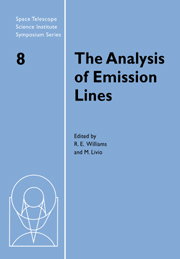Book contents
- Frontmatter
- Contents
- Participants
- Preface
- Emission Lines: Past and Future
- Atomic Data for the Analysis of Emission Lines
- Radiative Transfer
- Emission Lines from Winds
- Photoionizing Shocks
- The Lexington Benchmarks for Numerical Simulations of Nebulae
- Emission Line Diagnostics
- Ultraviolet Spectroscopy
- Infrared Emission Lines as Probes of Gaseous Nebulae
- Molecular Emission Line Diagnostics in Astrophysical Environments
- Abundance Determinations
- Astrophysical Gamma Ray Emission Lines
- Summary Remarks
Astrophysical Gamma Ray Emission Lines
Published online by Cambridge University Press: 23 November 2009
- Frontmatter
- Contents
- Participants
- Preface
- Emission Lines: Past and Future
- Atomic Data for the Analysis of Emission Lines
- Radiative Transfer
- Emission Lines from Winds
- Photoionizing Shocks
- The Lexington Benchmarks for Numerical Simulations of Nebulae
- Emission Line Diagnostics
- Ultraviolet Spectroscopy
- Infrared Emission Lines as Probes of Gaseous Nebulae
- Molecular Emission Line Diagnostics in Astrophysical Environments
- Abundance Determinations
- Astrophysical Gamma Ray Emission Lines
- Summary Remarks
Summary
We review the wide range of astrophysical observations of gamma ray emission lines and we discuss their implications. We consider line emission from solar flares, the Orion molecular cloud complex, supernovae 1987A and 1991T, the supernova remnants Cas A and Vela, the interstellar medium, the Galactic center region and several Galactic black hole candidates. The observations have important, and often unique, implications on particle acceleration, star formation, processes of nucleosynthesis, Galactic evolution and compact object physics.
Introduction
Gamma ray lines are the signatures of nuclear and other high energy processes occurring in a wide variety of astrophysical sites, ranging from solar flares and the interstellar medium to accreting black holes and supernova explosions. Their measurement and study provide direct, and often unique, information on many important problems in astrophysics, including particle acceleration, star formation, nucleosynthesis and the physics of compact objects.
The physical processes that produce astrophysical gamma ray emission lines are nuclear deexcitation, positron annihilation and neutron capture. Excited nuclear levels can be populated by the decay of long-lived radioactive nuclei as well as directly in interactions of accelerated particles with ambient gas. Nuclear deexcitation lines following radioactive decay have been seen from supernova 1987A (Matz et al. 1988; Tueller et al. 1990; Kurfess et al. 1992), from the supernova remnants Cas A (Iyudin et al. 1994) and Vela (Diehl et al. 1995), and the interstellar medium (Mahoney et al. 1984; Share et al. 1985; Diehl et al. 1994; 1995).
- Type
- Chapter
- Information
- The Analysis of Emission Lines , pp. 180 - 213Publisher: Cambridge University PressPrint publication year: 1995
- 5
- Cited by



